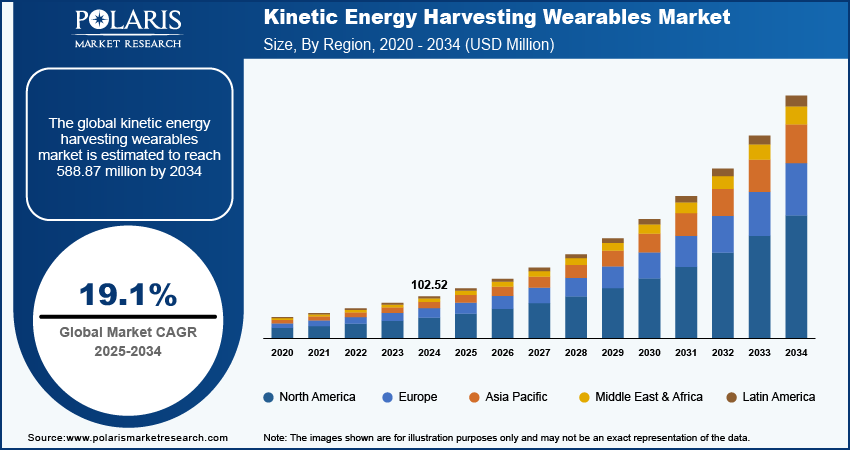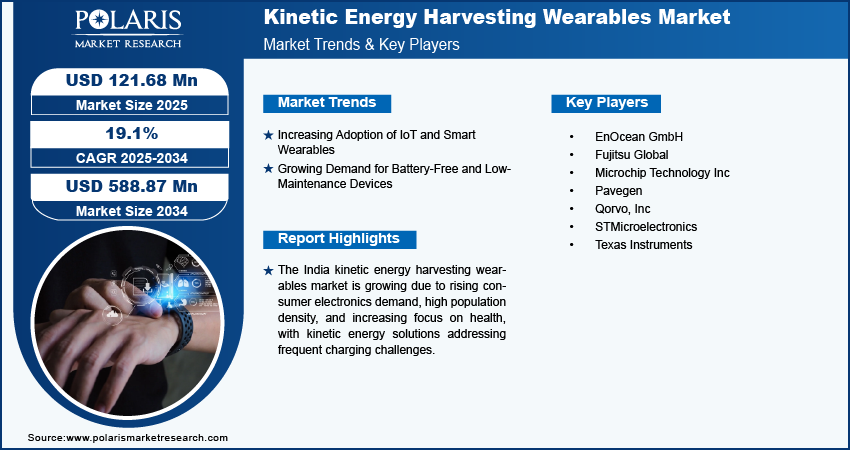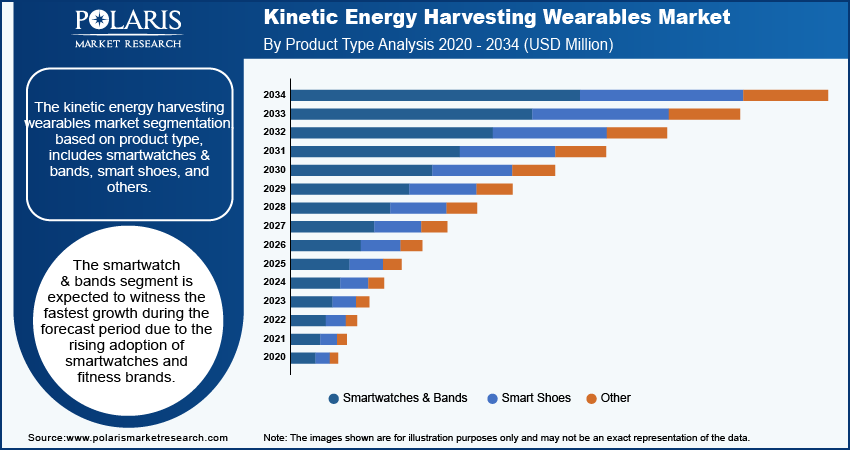
Kinetic Energy Harvesting Wearables Market Size, Share, Trends, Industry Analysis Report: By Product Type (Smartwatches & Bands, Smart Shoes, and Other), Technology, Application, and Region (North America, Europe, Asia Pacific, Latin America, and Middle East & Africa) – Market Forecast, 2025–2034
- Published Date:Mar-2025
- Pages: 125
- Format: PDF
- Report ID: PM5410
- Base Year: 2024
- Historical Data: 2020-2023
Kinetic Energy Harvesting Wearables Market Overview
The global kinetic energy harvesting wearables market size was valued at USD 102.52 million in 2024. The market is projected to grow from USD 121.68 million in 2025 to USD 588.87 million by 2034, exhibiting a CAGR of 19.1% during 2025–2034.
Kinetic energy harvesting wearables are devices that capture and convert body movements, such as walking or running, into usable electrical energy to power sensors, smartwatches, fitness trackers, or medical devices. These wearables use technologies such as piezoelectric, electromagnetic, or triboelectric energy harvesting to create sustainable, battery-free, or extended-battery-life solutions.
The growing adoption of smartwatches, fitness trackers, and medical wearables is driving the demand for sustainable energy solutions. Traditional battery-powered wearables require frequent charging, limiting their convenience. Kinetic energy harvesting wearables offer a self-sustaining alternative, converting body movements into power. Consumers are increasingly prioritizing convenience, longer battery life, and eco-friendly technology, prompting companies to invest in energy-harvesting innovations. This is especially prominent in the health, fitness, and consumer electronics industries, where wearables devices are becoming essential for daily use, fitness tracking, and medical monitoring, thereby driving the kinetic energy harvesting wearables market demand.

To Understand More About this Research: Request a Free Sample Report
Continuous research and development in piezoelectric, electromagnetic, and triboelectric energy harvesting technologies are making kinetic energy harvesting more efficient and viable for wearables. Modern energy harvesters can capture even small amounts of motion-generated energy and efficiently convert it into usable power. Improved energy storage solutions, such as advanced supercapacitors and low-power electronic components, further improve the effectiveness of these devices. Kinetic energy harvesting wearables are becoming more compact, lightweight, and capable of providing longer-lasting power as the technology matures, making them more attractive to both consumers and industries, thereby fueling the kinetic energy harvesting wearables market development.
Kinetic Energy Harvesting Wearables Market Dynamics
Increasing Adoption of IoT and Smart Wearables
The Internet of Things (IoT) is fueling the expansion of connected wearables devices across various industries. Smart wearables, including fitness trackers, health monitors, and industrial safety gear, depend on continuous data collection and transmission. Powering these devices without frequent recharging presents a significant challenge. The demand for energy-efficient, self-sustaining wearables rises as IoT applications grow, driving more investments in energy-harvesting solutions. Thus, the rising adoption of IoT and smart wearables is boosting the kinetic energy-harvesting wearables market growth.
Growing Demand for Battery-Free and Low-Maintenance Devices
One of the biggest limitations of wearables devices is battery life, which requires regular charging or replacement. In industries such as healthcare, military, and industrial applications, uninterrupted device operation is crucial. Kinetic energy harvesting eliminates the need for frequent battery replacements, reducing maintenance efforts and costs. This is beneficial for medical wearables such as continuous glucose monitors and implantable sensors, where reliable power is essential. Thus, the demand for battery-free or low-maintenance energy-harvesting wearables is rising as businesses and consumers are seeking more convenient, self-sufficient solutions, thereby driving the kinetic energy harvesting market growth.

Kinetic Energy Harvesting Wearables Market Segment Analysis
Kinetic Energy Harvesting Wearables Market Assessment by Product Outlook
The kinetic energy harvesting wearables market segmentation, based on products, includes smartwatches & bands, smart shoes, and others. The smartwatch & bands segment is expected to witness the fastest growth during the forecast period due to the rising adoption of smartwatches and fitness brands. This rising demand for smartwatches and bands is driven by the increasing disposable income of the general population, which is supporting the population to spend more on essential items such as smartwatches to monitor health parameters.
Kinetic Energy Harvesting Wearables Market Evaluation by Application Outlook
The kinetic energy harvesting wearables market, based on application, is segmented into consumer electronics, healthcare, sports & fitness, and others. The consumer electronics segment dominated the kinetic energy harvesting wearables market share in 2024 due to factors such as rising population density coupled with changing lifestyle habits. The general population is highly prioritizing comfort for daily essentials, due to which the demand for battery wearables is increasing, thereby driving segmental growth.

Kinetic Energy Harvesting Wearables Market Regional Analysis
By region, the study provides the kinetic energy harvesting wearables market insights into North America, Europe, Asia Pacific, Latin America, and the Middle East & Africa. In 2024, North America dominated the global kinetic energy harvesting wearables market share, driven by the increasing demand for consumer electronics due to high disposable income in the region. According to the Federal Reserve Bank of St. Louis, in 2024, the disposable income of the general population of the US was recorded at USD 63,668, showcasing the high disposable income. Additionally, companies are investing more in developing wearables that can generate their own power as consumers prioritize longer battery life and eco-friendly solutions, thereby driving the kinetic energy harvesting wearables market expansion in North America.
Asia Pacific is expected to record a significant share during the forecast period due to rapid urbanization, rising disposable incomes, and a tech-savvy population. Demand for wearables devices such as fitness trackers and smartwatches is increasing as consumers prioritize sustainability and convenience. The presence of major electronics manufacturers and a growing number of innovative startups in the region is further fueling the Asia Pacific kinetic energy harvesting wearables market growth.
The India kinetic energy harvesting wearables market is experiencing substantial growth due to the rising demand for consumer electronics and the country’s high population density. More consumers are adopting wearables devices such as fitness trackers and smartwatches, driven by an increasing focus on health and fitness. The need for frequent charging is a challenge, making kinetic energy harvesting a valuable solution as it allows wearables to function without constant recharging. Additionally, India’s large and growing population, combined with rising disposable incomes, is further boosting the demand for wearables technologies, thereby driving the kinetic energy harvesting wearables market expansion in India.

Kinetic Energy Harvesting Wearables Market – Key Players & Competitive Analysis Report
The kinetic energy harvesting wearables market is constantly evolving, with numerous companies striving to innovate and distinguish themselves. Leading global corporations dominate the market by leveraging extensive research and development, and advanced techniques. These companies pursue strategic initiatives such as mergers and acquisitions, partnerships, and collaborations to enhance their product offerings and expand into new markets.
New companies are impacting the kinetic energy harvesting wearables industry by introducing innovative products to meet the demand of specific market sectors. This competitive environment is amplified by continuous progress in product offerings. A few major players in the kinetic energy harvesting wearables market include EnOcean GmbH; Fujitsu Global; Microchip Technology Inc; Pavegen; Qorvo, Inc ; STMicroelectronics; and Texas Instruments.
EnOcean GmbH, a German company established in 2001 as a spin-off from Siemens AG, focuses on energy-harvesting wireless technology for various applications, particularly in building automation. Headquartered in Oberhaching, near Munich, EnOcean operates globally. The company's technology converts ambient energy into power, eliminating the need for batteries and reducing electronic waste. Its technology has been integrated with the Internet of Things (IoT), advancing the development of smarter, more connected buildings and improving efficiency and flexibility. EnOcean manufactures and markets wireless sensor solutions for use in buildings and industrial installations. Their product portfolio includes kinetic switches and self-powered sensors, as well as software kits, tools, and firmware for IoT applications. EnOcean's sensors utilize energy derived from slight deviations in temperature or pressure, freeing them from external power sources. These sensors are used by original equipment manufacturers (OEMs) in building and home automation, intelligent buildings, industrial manufacturing, and automotive technology. EnOcean also offers Easyfit products, which are self-powered switches and sensors using wireless standards such as EnOcean and Bluetooth Low Energy for energy-efficient LED lighting solutions. The ECO 200 is a kinetic energy harvester module for linear motion, powering EnOcean radio modules such as the PTM 535 family. It enables self-powered buttons and switches. Headquartered in Oberhaching, near Munich, EnOcean has offices in Germany and the USA and serves customers internationally. Their team combines decades of experience in the field. EnOcean's wireless technology is used in over a million buildings worldwide. EnOcean wireless technology is based on the efficient exploitation of slight mechanical motion and other environmental potentials, such as indoor light and temperature differences, using energy harvesting principles. Miniaturized energy converters, ultra-low power electronics, and robust radio technology based on open standards (EnOcean, Zigbee, and Bluetooth) form the foundation for digitized buildings, services, and production processes in the IoT.
Qorvo, Inc. is an American multinational company focused on radio frequency (RF) and power solutions for wireless, wired, and power markets. Established in 2015 through the merger of TriQuint Semiconductor and RF Micro Devices (RFMD), Qorvo is a participant in the S&P 500. Headquartered in Greensboro, North Carolina, the company's activities include the design, development, manufacture, and marketing of semiconductor solutions aimed at connectivity and power applications across various sectors, such as consumer electronics, smart home, automotive, network infrastructure, healthcare, and defense. Qorvo operates through two segments—mobile products (MP) and infrastructure and defense products (IDP). The mobile products segment supplies RF solutions for mobile devices such as smartphones, notebooks, tablets, wearables, and cellular-based IoT applications, offering RF front-end (RFFE) components, including power amplifiers (PAs), low noise amplifiers (LNAs), and filters. The company's product range also includes amplifiers, control products, discrete transistors, filters & duplexers, frequency converters & sources, integrated products, low power IoT devices, optical components, passives, power management solutions, and switches. Qorvo has operations in Asia, Europe, and North America. Design and manufacturing facilities are located in North Carolina, Oregon, Texas, and Florida, with assembly and test facilities primarily based in China, Costa Rica, and Texas. The US accounts for a significant portion of Qorvo's revenue (65.77%), followed by China (15.23%) and Other Asia (8.7%).
List of Key Companies in Kinetic Energy Harvesting Wearables Market
- EnOcean GmbH
- Fujitsu Global
- Microchip Technology Inc
- Pavegen
- Qorvo, Inc
- STMicroelectronics
- Texas Instruments
Kinetic Energy Harvesting Wearables Market Segmentation
By Product Type Outlook (Revenue USD Million, 2020–2034)
- Smartwatches & Bands
- Smart Shoes
- Other
By Technology Outlook (Revenue USD Million, 2020–2034)
- Piezoelectric Energy Harvesting
- Electromagnetic Energy Harvesting
- Triboelectric Energy Harvesting
- Others
By Application Outlook (Revenue USD Million, 2020–2034)
- Consumer Electronics
- Healthcare
- Sports & Fitness
- Others
By Regional Outlook (Revenue USD Million, 2020–2034)
- North America
- US
- Canada
- Europe
- Germany
- France
- UK
- Italy
- Spain
- Netherlands
- Russia
- Rest of Europe
- Asia Pacific
- China
- Japan
- India
- Malaysia
- South Korea
- Indonesia
- Australia
- Rest of Asia Pacific
- Middle East & Africa
- Saudi Arabia
- UAE
- Israel
- South Africa
- Rest of Middle East & Africa
- Latin America
- Mexico
- Brazil
- Argentina
- Rest of Latin America
Kinetic Energy Harvesting Wearables Market Report Scope
|
Report Attributes |
Details |
|
Market Size Value in 2024 |
USD 102.52 million |
|
Market Size Value in 2025 |
USD 121.68 million |
|
Revenue Forecast by 2034 |
USD 588.87 million |
|
CAGR |
19.1% from 2025 to 2034 |
|
Base Year |
2024 |
|
Historical Data |
2020–2023 |
|
Forecast Period |
2025–2034 |
|
Quantitative Units |
Revenue in USD million and CAGR from 2025 to 2034 |
|
Report Coverage |
Revenue Forecast, Market Competitive Landscape, Growth Factors, and Trends |
|
Segments Covered |
|
|
Regional Scope |
|
|
Competitive Landscape |
|
|
Report Format |
|
|
Customization |
Report customization as per your requirements with respect to countries, regions, and segmentation. |
FAQ's
The kinetic energy harvesting wearables market size was valued at USD 102.52 million in 2024 and is projected to grow to USD 588.87 million by 2034.
The global market is projected to register a CAGR of 19.1% during the forecast period.
North America held the largest share of the global market in 2024.
A few key players in the market are EnOcean GmbH; Fujitsu Global; Microchip Technology Inc; Pavegen; Qorvo, Inc; STMicroelectronics; and Texas Instruments.
The consumer electronics segment dominated the market in 2024, due to factors such as rising population density and changing lifestyle habits.
The smartwatch & bands segment is expected to witness the fastest growth during the forecast period due to the rising adoption of smartwatches and fitness brands.
